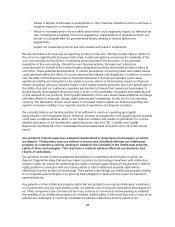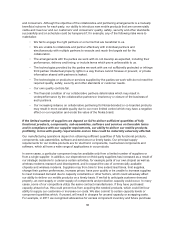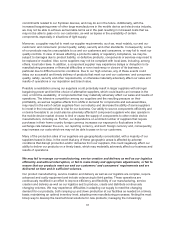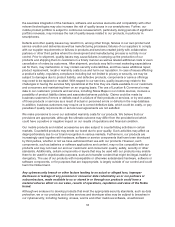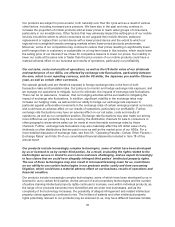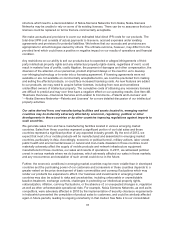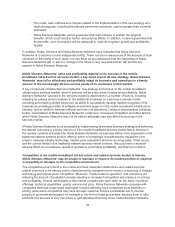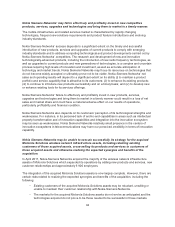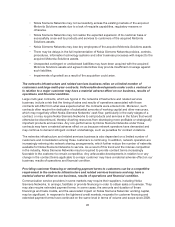Nokia 2011 Annual Report Download - page 39
Download and view the complete annual report
Please find page 39 of the 2011 Nokia annual report below. You can navigate through the pages in the report by either clicking on the pages listed below, or by using the keyword search tool below to find specific information within the annual report.structure which lead to a deconsolidation of Nokia Siemens Networks from Nokia, Nokia Siemens
Networks may be unable to rely on some of its existing licenses. There can be no assurance that such
licenses could be replaced on terms that are commercially acceptable.
We make accruals and provisions to cover our estimated total direct IPR costs for our products. The
total direct IPR cost consists of actual payments to licensors, accrued expenses under existing
agreements and provisions for potential liabilities. We believe that our accruals and provisions are
appropriate for all technologies owned by others. The ultimate outcome, however, may differ from the
provided level which could have a positive or negative impact on our results of operations and financial
condition.
Any restrictions on our ability to sell our products due to expected or alleged infringements of third-
party intellectual property rights and any intellectual property rights claims, regardless of merit, could
result in material loss of profits, costly litigation, the payment of damages and other compensation, the
diversion of the attention of our personnel, product shipment delays or the need for us to develop
non-infringing technology or to enter into a licensing agreement. If licensing agreements were not
available or are not available on commercially acceptable terms, we could be precluded from making
and selling the affected products, or could face increased licensing costs. As new features are added
to our products, we may need to acquire further licenses, including from new and sometimes
unidentified owners of intellectual property. The cumulative costs of obtaining any necessary licenses
are difficult to predict and may over time have a negative effect on our operating results. See Item 4B.
“Business Overview—Devices & Services and Location & Commerce—Patents and Licenses” and
“—Nokia Siemens Networks—Patents and Licenses” for a more detailed discussion of our intellectual
property activities.
Our sales derived from, and manufacturing facilities and assets located in, emerging market
countries may be materially adversely affected by economic, regulatory, political or other
developments in those countries or by other countries imposing regulations against imports to
such countries.
We generate sales from and have manufacturing facilities located in various emerging market
countries. Sales from those countries represent a significant portion of our total sales and those
countries represent a significant portion of any expected industry growth. By the end of 2012, we
expect that most of our mobile products will be manufactured and assembled in emerging market
countries, particularly in Asia. Accordingly, economic or political turmoil, military actions, labor unrest,
public health and environmental issues or natural and man-made disasters in those countries could
materially adversely affect the supply of mobile products and network infrastructure equipment
manufactured in those countries, our sales and results of operations. In 2011, we witnessed political
unrest in various markets where we do business, which adversely affected our sales in those markets,
and any reoccurrence and escalation of such unrest could do so in the future.
Further, the economic conditions in emerging market countries may be more volatile than in developed
countries and the purchasing power of our customers and consumers in those countries depends to a
greater extent on the price development of basic commodities and currency fluctuations which may
render our products too expensive to afford. Our business and investments in emerging market
countries may also be subject to risks and uncertainties, including unfavorable or unpredictable
taxation treatment, exchange controls, challenges in protecting our intellectual property rights,
nationalization, inflation, currency fluctuations, or the absence of, or unexpected changes in, regulation
as well as other unforeseeable operational risks. For example, Nokia Siemens Networks, as well as its
competitors, were adversely affected in 2010 by the implementation of security clearance requirements
in India which prevented the completion of product sales to customers, and could be similarly affected
again in future periods, leading to ongoing uncertainty in that market. See Note 2 to our consolidated
37



